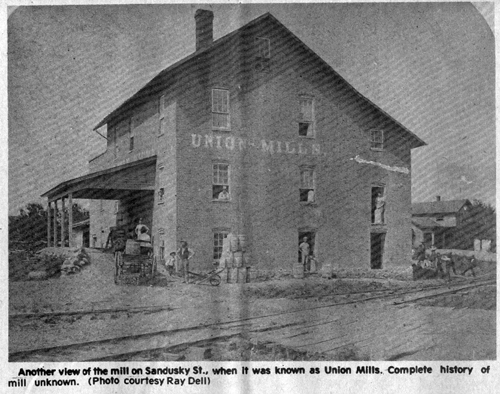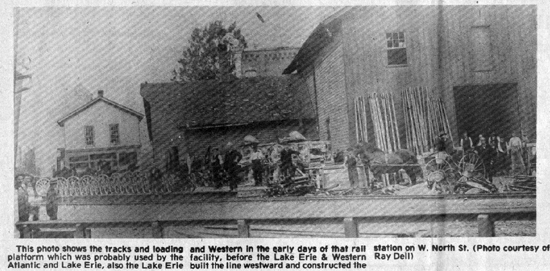July 14, 1983


Picture #1 (missing) – The north end of Fostoria’s business area, once called Times Square, where Sandusky St. leads eastward from Main.
Picture #2 – Another view of the mill on Sandusky St., when it was known as Union Mills. Complete history of mill unknown.
Picture #3 – This photo shows the tracks and loading platform which was probably used by the Atlantic and Lake Erie, also the Lake Erie and Western in the early days of that rail facility, before the Lake Erie & Western built the line westward and constructed the station on W. North Street.
Author’s Note: Today’s article is the first in a series about Sandusky Street, which once, I believe was considered more important than it is today, if for no other reason than for the presence of two means of transportation.. .the Fostoria & Fremont (F&F) electric interurban, and the Lake Erie & Western (LE&W) railroad whose tracks were both located on that thoroughfare. Watch for each article, which may not appear consecutively.
I once wrote that Sandusky Street got its name because it led to Sandusky. No one challenged me, and I’ll leave that statement stand.
It is a fact that no other street in Fostoria iver had two sets of tracks side-by-side, as did Sandusky, the one set of tracks accommodated the Atlantic and Lake Erie, later to become the LE&W…often referred to as “leave early and walk”. That railroad offered both freight and passenger service.
The LE&W depot is now the Camp Fire headquarters. It still has the appearance of a depot, but the caboose, parked on a short length of the original tracks, is the only piece of memorabilia from the earlier days. The caboose was obtained through the single efforts of “Burley” Moore of the Union Carbide firm.
The second set of tracks accommodated the F&F interurban which made connections with another electric railway in Fremont, making it possible to reach Cleveland. Many Fostorians used it.
Sandusky Street has had other advantages too…well-kept homes and good citizens; a variety of business and industry; an elementary school, officially named Longfellow, but generally just called Sandusky.
Your author is qualified to write about Sandusky Street since he lived close to it for nearly 15 years; carried The Review on that street; knew and dealt with several of the merchants, and also knew many of the people who resided there. More about all of those elements as this series of articles progresses.
I do not know if there are any records showing when Sandusky Street was built but it must have been very early in the town’s history. At first, it was just a dirt surface, which became very muddy during the rainy season. That condition was corrected when Gene Wilson, the Fostorian who was acclaimed the champion bricklayer in “Believe It Or Not” gave it a hard surface of probably the best material ever devised for streets, heavy duty bricks.
At another period early in the town’s history trees were cut and laid transversely to make a corduroy road through the wilderness to Fremont. That road may have been bumpy but it was better than the swampy condition which impeded horse and wagon travel of that day.
Where Sandusky, Main and Perry Streets come together was known as Times Square. It derived its name from the time when Roscoe Carle established The Times and The Democrat in the triangular-shaped building at Main and Perry, where the Sohio station is today. the panoramic view with today’s article shows the square and the building from which it gots its name.
The large open “square” provided an excellent view of the downtown area as well as Sandusky Street. From that vantage point you could see approaching trains and interurbans. There was always action on Times Square in the earlier days…more business places (at least 20 or more) to create action… there were horse and buggies, followed by the early autos…more people on the streets.
The panoramic photo with today’s article was taken during the latter part of the 1800’s. It shows very well how Sandusky Street ties in with the business district.
The set of rail tracks shown in the foreground are those of the Toledo, Fostoria, & Findlay (TF&F) interurban which turned off to the left onto Perry Street. The TF&F interurban did not come into existence until 1911, many years after the photo was taken, and it went out of existence in 1932, at which time all three electric interurban lines, serving Fostoria “folded”. The third one was the Tiffin, Fostoria & Eastern (TF&E).
The F&F tracks, as stated earlier, paralleled the LE&W which can be seen located close to the building in the center of the photo. The F&F tracks curved south onto Main Street, the interurban station being where Bill’s Men & Boy’s Wear store is today.
The Atlantic and Lake Erie (A&LE) railroad preceded the LE&W and laid out the right-of-way in Fostoria on Sandusky Street which continued to be used. However, the earlier right-of-way terminated at Main Street and the depot and platform was possibly just off Main on Sandusky, perhaps about where the Candyland restaurant is.
Back in the early part of this century, when Cedar Point was a popular bathing beach and amusement resort, the LE&W ran excursions, starting at Ft. Wayne, IN., on to Sandusky. Trains with a dozen or more coaches carried hundreds of people there. The passengers were ferried from Sandusky to the Point on large steamers. My boyhood friends Wilbur Sheely and I took that trip one summer day nearly 70 years ago.
The LE&W and the F&F both made important contributions to the education of young people living in the Amsden and Kansas area. When their elementary education was completed in the rural school, they came to Fostoria High daily via those two means of transportation. Those I can recall are Ralph Hartline, John Baldwin, Lucille Amaugher, Mead Miller, Early Byers, Raymond Rouser…maybe others I’ve forgotten.
The corner of the building which can be seen in the extreme right of the panoramic photo was part of a row of framed structures owned by the Cadwallader family, and used as business rooms and residences. Readers may detect the sign extending from the corner building, reading The Old Homestead.
Others to occupy the corner, and those on Sandusky Street (south side) to the intersection of Potter Street follow.
Foremost in the author’s recollection was R.W. “Skip” Emison’s Restaurant. Aside from the good food served at very reasonable prices was “Skip” himself. He composed jingles about the moment, the town and people…always getting a laugh from customers.
Others in that corner spot were N.E. George’s grocery and fruit market; Lavery’s Delicatessen and later lavery’s Bar.
No. 105 – John Geiger, barber; Ira Johnson, confectionery; Tillie’s Lunch (Tillie Bishop and Robert Barton).
No. 109 – H.L. Weston; J.J. Gaster; Mike Brown, Shoe repair.
No. 113 – O.K. Jeweler (Stanley W. Groomes)
No. 113 1/2 – Roy Hartsook, residence
No. 114 – Luther S. tyler, contractor
No. 117 – Miller’s Lunch (Glenna I. Williams)
No. 119 – C.W. Good, cement work; Richard K. Crull, residence
Corner Potter & Sandusky: C.W. Stockwell, residence; (a painter by trade); later Spiro Fakalos resided there; still later Raymond Wagner of Star Glass and Supply.
As the panoramic photo so well depicts, there were not many business places on the north side of Sandusky Street in the first block off Main at the time it was taken.
The two-story building once The Oil Well Supply Co., now houses George Pappas Candyland Restaurant. The rear of that building has been a barbershop for many years, once owned by Alan Anderson, now Mel’s Barber Shop.
In the right and background of the photo can be seen the mill which was located there for many years, possibly as far back as the 1870’s. It is also shown in a separate photo, which shows that it was once known as Union Mills.
It is not know if it was always just a grist mill or if flour was also produced. Back then a lot of coarse meals were custom ground.
Who all may have owned the mill and when it was built is unknown, but it is known that the Cadwallader family was probably a practical, if not complete owner at one time. Mr. and Mrs. Ira Cadwallader still possess and old stock certificate dated 1890, showing Ira Cadwallader (I) as president and G.C. Davis as Secretary.
On Aug. 8, 1893, according to a news item (from The Review) the mill suffered a disastrous fire caused by a boiler explosion, in which two died, George C. Davis and Fred C. Myers.
The mill was restored and continued until about 1931, when again it burned but it was not restored.
Many readers will recall that the Low Price Filling Station did business at that location for many years afterward.